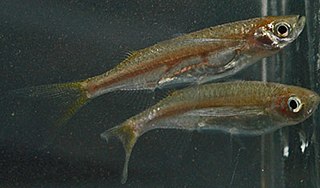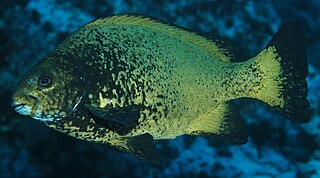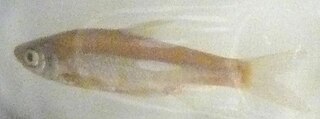
Parachela is a genus of freshwater ray-finned fish belonging to the family Xenocyprididae, the East Asian minnows or sharpbellies. These fishes are found in Asia.

The sea chubs, also known as rudderfish and pilot fish and in Hawaiian as enenue or nenue, are a family, Kyphosidae, of fishes in the order Perciformes native to the Atlantic, Indian and Pacific Oceans usually close to shore in marine waters.

Ischikauia is a monospecific genus of freshwater ray-finned fish belonging to the family Xenocyprididae, the East Asian minnows or sharpbellies. The only species in the genus is Ischikauia steenackeri, the wataka, which is endemic to Lake Biwa in Japan. This species was originally described as Opsariichthys steenackeri.

Chelaethiops is a genus of freshwater ray-finned fishes belonging to the family Danionidae, the danionins or danios. The fishes in thuis genus are found in lakes and rivers of Africa. While commonly called "sardines", they are not related to the true sardines of the family Clupeidae.

Zacco is a genus of small freshwater ray-finned fishes belonging to the family Xenocyprididae, the East Asian minnows or sharpbellies. They are found in freshwater habitats in China and northern Vietnam. The generic name Zacco derives from the Japanese Zako雑魚.
Araiocypris is a monospecific genus of freshwater ray-finned fish belonging to the family Xenocyprididae, the East Asian minnows or sharpbellies. The only species in the genus is Araiocypris batodes, a very small fish endemic to Vietnam.
Atrilinea is a genus of freshwater ray-finned fishes belonging to the family Xenocyprididae. This is a small genus with three valid species, all of which are endemic to China.

Bangana is a genus of fish in the family Cyprinidae, the carps and minnows. It is distributed across much of southern and eastern Asia. Species live mainly in the flowing waters of tropical and subtropical rivers.

Candidia is a genus of freshwater ray-finned fishes belonging to the family Xenocyprididae. This is a small genus with two valid species, all of which are endemic to Taiwan.
Hemiculterella is a genus of freshwater ray-finned fishes belonging to the family Xenocyprididae, the East Asian minnows or sharpbellies. The fishes in this genus occur in eastern Asia. There are currently three species in this genus.

Leptocypris is a genus of freshwater ray-finned fishes belonging to the family Danionidae, the danios or danionins. The fishes in this genus are found in Africa

Luciosoma is a genus of freshwater ray-finned fish belonging to the family Danionidae, the danionins or danios. The fishes in this genus are found in Southeast Asia
Malayochela is a monospecific genus of freshwater ray-finned fish belonging to the family Danionidae, the danios or danionins. The only species in the genus is Malayochela maassi, a fish found in Peninsular Malaysia, Sumatra and Kalimantan
Ochetobius is a monospecific genus of freshwater ray-finned fish belonging to the family Xenocyprididae, the East Asian minnows or sharpbellies. The only species in the genus is Ochetobius elongatus, a fish found in eastern Asia.

Oxygaster is a genus of freshwater ray-finned fish belonging to the family Xenocyprididae, the East Asian minnows or sharpbellies. The species in this genus are found in Southeast Asia.
Paralaubuca s a genus of freshwater ray-finned fish belonging to the family Xenocyprididae, the East Asian minnows or sharpbellies. The species in this genus are found in Asia.
Pseudohemiculter is a genus of freshwater ray-finned fish belonging to the family Xenocyprididae, the East Asian minnows or sharpbellies. The four species in this genus are found in eastern Asia.

Toxabramis is a genus of freshwater ray-finned fish belonging to the family Xenocyprididae, the East Asian minnows or sharpbellies. These fishes are found in Eastern Asia,
Xenobarbus is a monospecific genus of freshwater ray-fiined fish belonging to the family Cyprinidae. the family which includes the carps, barbs and related fishes. The only species in the genus is Xenobarbus loveridgei which is endemic to Tanzania where it is found in Lake Victoria. The species is rare and only known from a few specimens.

Nematabramis alestes is a species of freshwater ray-finned fish belonging to the family Danionidae, the danionins or danios. This fish found in the Zamboanga Peninsula, Basilan, Palawan, and Busuanga Island of the Philippines. It belongs to the genus Nematabramis. It reaches up to 10.1 cm (4.0 in) in length.












